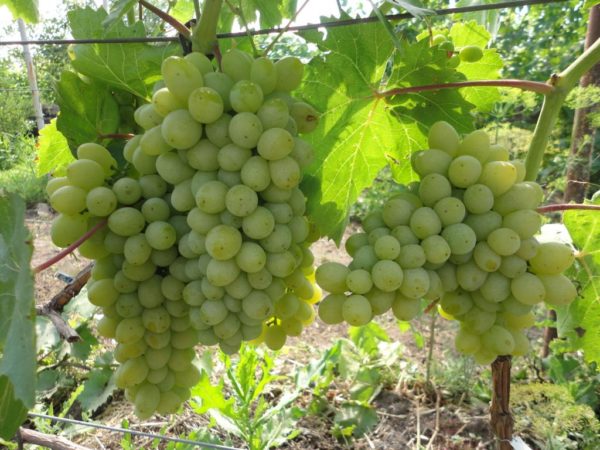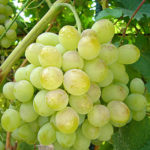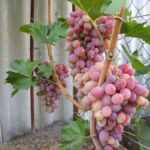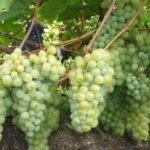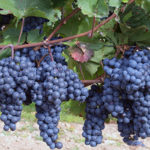Leading positions in the popularity rating are occupied by Grapes Delight for large fruits, high level of fruiting, good taste characteristics and ease of care.
Table of contents
Description and characteristics of grapes delight
By the time of ripening the grapes, Delight belongs to the category of early-season table varieties. Technical ripeness of the fruits occurs from 110 to 120 days after the start of the growing season. Harvesting takes place in mid-August.
Bushes form a powerful root system, which grows vertically to a depth of 2 m. The plant is decorated with foliage of medium size and light green color. Bushes with strong shapeless or conical clusters of moderate density, which reach in weight about 500 g And with proper care and favorable weather, the mass of one bunch can be 1.5-2 kg.
Shoots are characterized by excellent maturation, of which fruit-bearing - 70-85%. An average of 1.6 shoots per escape. Pruning of the vine should be carried out at the level of 6-10 eyes. The load on one plant should not exceed more than 45 eyes, which will allow you to get clusters of record sizes.
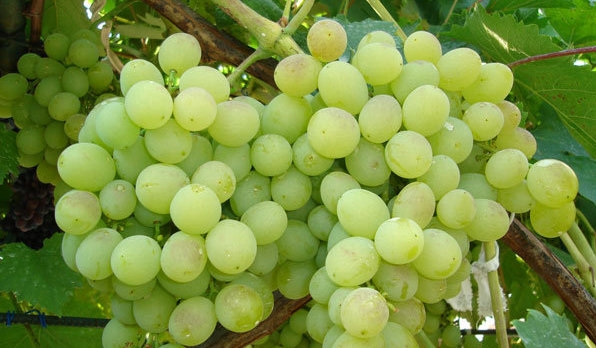
Characteristics of grape berries
The main feature of the variety are amber berries, which have the shape of an oval. At the stage of technical ripeness, they acquire a white tint with tan from the sun and are distinguished by a beautiful transparency and aroma with a nutmeg aftertaste. Juicy large berries endowed with crispy sweet flesh and skin of moderate density. The average size of the berries are approximately 2.7 x 2.4 cm, and the weight of one fruit ranges from 6 to 7 g.
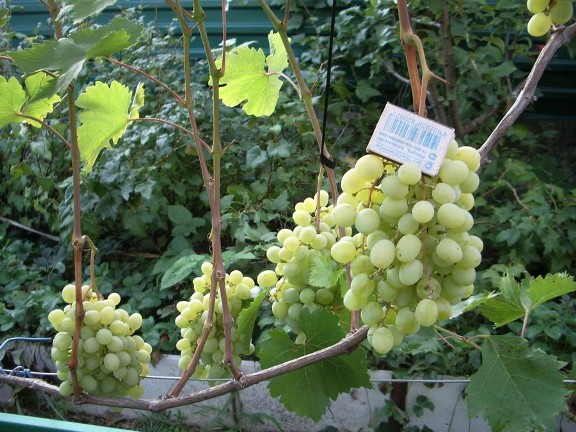
The advantages and disadvantages of the variety
The variety of grapes Delight has a lot of positive characteristics, which include:
- stable and high yield, which is 120 centners per hectare;
- beautiful shape of the grapes and excellent taste quality of the fruit;
- ability in the rapid growth of the vegetative mass;
- good rooting and unpretentiousness in cultivation and care;
- high immunity to the main diseases characteristic of the vine crop;
- frost resistance, the ability to tolerate a decrease in temperature indicators to -25̊ C;
- long preservation of fruits on the bushes without loss of taste and presentation;
- successfully transported over long distances;
- possibility of growing as an ornamental plant that does not require additional shelter.
In addition to significant advantages, the variety has disadvantages:
- propensity to overload, so you need the correct loading of the bush with a view to its more productive use;
- susceptibility to attack phylloxera.
Species diversity
The most popular are 4 types of this variety:
- Muscat This superearly table hybrid is obtained by crossing the varieties of Delight and Frumoas Albe. The plant enters fruiting in 2-3 years after planting. The vegetation period is 105 days. Harvesting can be carried out in early August. Large round berries. White skin that becomes amber when the fetus reaches full maturity. The pulp is distinguished by its density, juiciness with a balanced taste and light muscat aroma. Sugar content - up to 25%, acidity 7 g / l.
- Red. The variety is bred by crossing two varieties: Delight and Original. The ripeness of the fruit is observed 110-120 days after the formation of the kidneys. A characteristic feature of this species is large elongated berries, painted in red with an admixture of pink color and having a sweet-sour taste.
- White. This species is a high-yielding, early grape variety. The duration of its growing season is 115 days. From August to the last days of September, you can actively enjoy the harvest of ripe crops. Round fruits with a dense skin of white or light green color with the presence of wax and golden tan. Saturated taste is distinguished by harmony and special sweetness.Sugar content reaches 25%, acidity up to 9 g / l.
- The black. This is a hybrid, obtained using such hybrid forms as Delight White, Cardinal of Moldova, Timurovets. This early hybrid has a high percentage of yield. From the formation of ovaries to the removal of the crop takes 109-125 days. Large berries with a tender, juicy, sweet, slightly tart flesh and dark blue almost black dense thin skin. Sugar content 17–19%, acidity - 6 g / l.
- Delight white
- Delight red
- Muscat delight
- Delight black
Step-by-step cultivation
Grapes can be planted in spring and autumn. Experienced winegrowers recommend planting in the autumn, because the variety tolerates cold and the maximum amount of precipitation. During the winter, the plants take root, take root, and by the spring they begin to grow actively.
When choosing a place for planting, it is necessary to take into account both the aesthetic appearance of the garden plot and the needs of the plant for its normal growth, development and yield formation:
- the southern side of the site, illuminated by sunlight, protected from strong winds and drafts;
- depth of standing of groundwater not exceeding 2.5 m;
- light loam or chernozem depth up to 70 cm
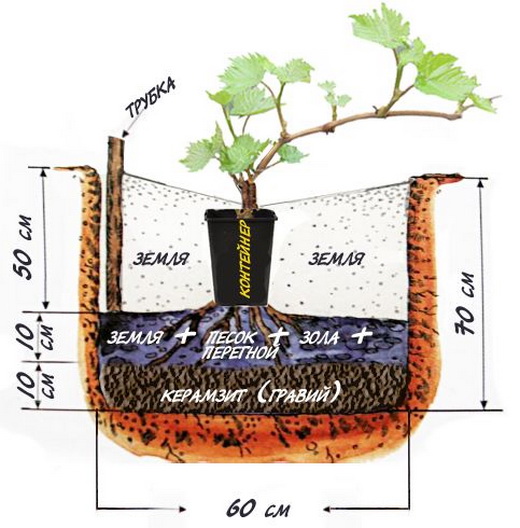
Stages of the landing process:
- Make holes under the seedlings, the size of which should ensure the free location of the plant root system. The distance between the landing units should be not less than 4 m in order to avoid interlacing and shading.
- Pour drainage to the bottom of the wells., which may be gravel, crushed stone or broken brick.
- Drainage layer is filled with granulated mineral fertilizers or organic substances.
- Install peg which will be in the process of growing vines of grapes to serve as a reliable support.
- To the top sprinkle some fertile soil, to save the fragile young roots of the plant from burning with fertilizers.
- Plant out seedlingsby dropping them into the wells so that the branch point of the shoots is above 3 cm above the ground.
- Cover with fertile soil, tightly tamping to avoid the formation of voids.
- At the end of the landing good waterUsing water at room temperature and grind the soil around the tree circle using peat or humus.
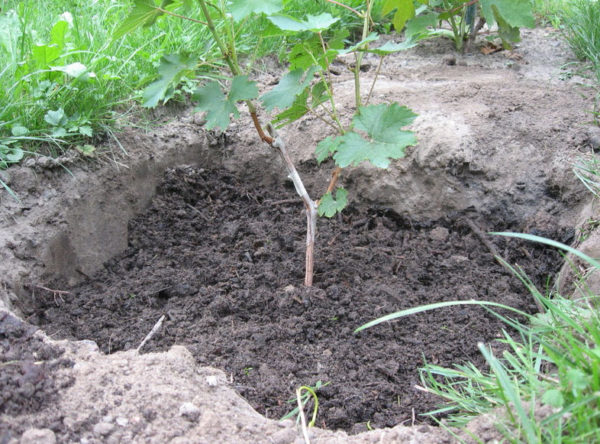
Care for a young and mature vine
The implementation of the necessary measures for the care allows the plant in the shortest period to enter into fruiting and for a long time to form high-quality yields.
For this, the following set of basic operations should be carried out:
- observe the conditions of soil moisture, systematically watering the plants before and after flowering, when the fruits begin to fill in, preparing for maturation;
- to form a bush that will help stimulate the growth of the plant in order to increase yield.
- to pick off too thick leaves already on an adult bush to ensure sufficient light to the clusters;
- time to process the plant from the invasion of pests and disease, using proven protective agents;
- for better growth and fertility to make nutrients before flowering, when the fruits were formed and at the time of active maturation;
- take care of the shelter of young grape bushes for the winter to save the plants from severe frosts and sudden changes in temperature.
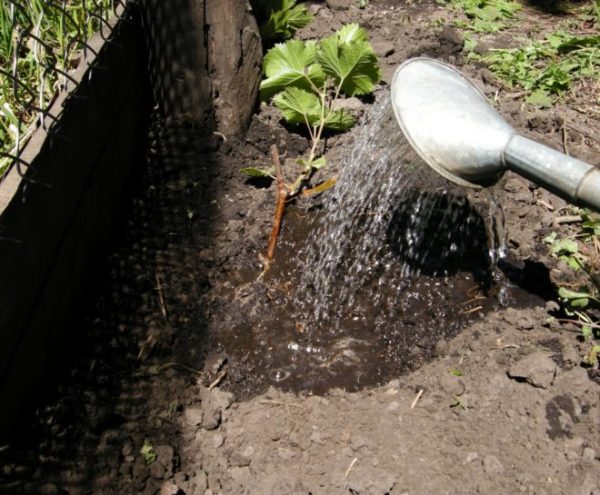
Breeding methods
Growing grapes is possible in several ways:
- Grafting a cutting to the stock of an old bush, on a perennial stock of wood. This method is good because the cuttings do not need time to accumulate resources. All they need for intensive development is to build on the stock. The grapes cultivated by grafting will start to bear fruit faster.
- Reproduction with seedlings. This method is considered simple and efficient. From the cuttings harvested in the autumn, in the spring, ready-made seedlings with all the qualities can be transplanted, characteristic of the uterine plant.
- Reproduction shoots from fruiting adult bush. To do this, choose strong healthy shoots and prikopat them near the trunk of an adult plant. After a while they will take root and begin to develop as independent units. After that, they can be separated and transplanted to a permanent place.
- Cultivation from a stone. This is a complex method, since for this you should use only strong and fresh bones. And it will also require a fertile substrate, time for the germination process and a lot of attention from the grower.
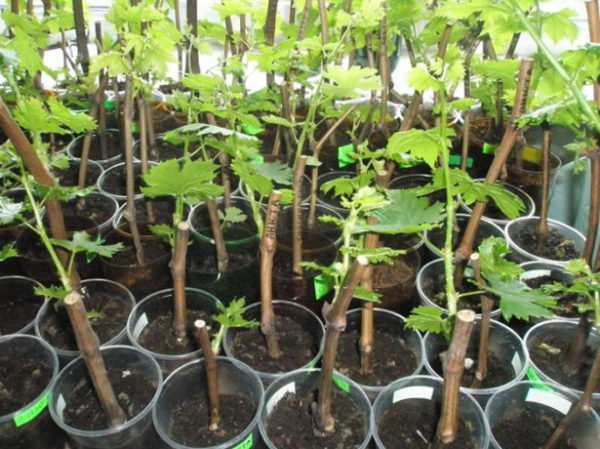
Diseases and pests
According to the description, Delight is good against common diseases and dangerous pests. Even with all the advantages of culture, it is necessary to implement a number of preventive measures to protect the plant from infections and fungi. To do this, spray with special products during the vegetative season.
Experienced and novice winegrowers successfully cultivate Delight grapes, because it fully justifies its name. The reason is the size of the fruit, high yield of the crop, friendly fruiting and cold resistance. And beautiful attractive grape vines decorate garden arbors, hedges and other elements of the local area.
